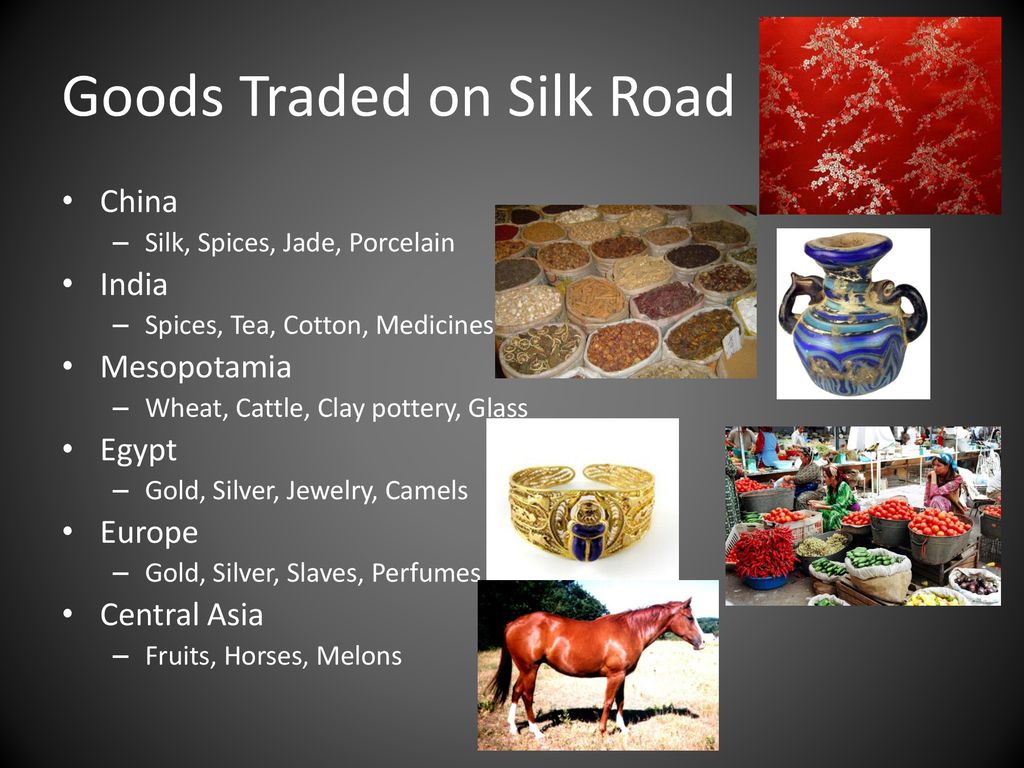Spanning over 6,400 kilometers (4,000 miles), it played a central role in facilitating economic, cultural, political, and religious interactions between the east and west.What items were traded on the silk road?
Silk went westward, and wools, gold, and silver went east.July 2, 2024 | last updated:Path followed by merchants or explorers to exchange goods and services.
Produced almost exclusively in china as early as 3000 bc, silk soon became one of the most sought after products in the world.As the name suggests, one of the most important items traded along the silk road was indeed silk.
The silk road was a network of paths connecting civilizations in the east and west that was well traveled for approximately 1,400 years.Silk roads, will challenge and expand the modern popular concept of the 'silk road' as a simple history of trade between 'east' and 'west'.It flourished through the byzantine empire, song and tang dynasties, and the mongol.
It is a reminder of the difficulties the traveling merchant once faced with his camel caravan, as they traveled across waterless, scorching hot desert stretches and the highest mountain ranges on earth.Ross ulbricht created the first anonymous dark web marketplace silk road where drugs and other items were traded for bitcoin, and was arrested and sentenced.
This time witnessed significant leaps in connectivity and the.For more than 1,500 years, the network of routes known as the silk road contributed to the exchange of goods and ideas among diverse.
Last update images today What Items Were Traded On The Silk Road
 What The Numbers Tell Us About Shakur Stevenson Vs. Artem Harutyunyan
What The Numbers Tell Us About Shakur Stevenson Vs. Artem Harutyunyan
ONE AFTERNOON IN June, after a minicamp practice in the smothering Florida heat, Miami Dolphins defensive tackle Zach Sieler and his teammates received welcome news: Practice the following day was canceled.
But for Sieler, the good news wouldn't end there.
As the six-year veteran finished answering questions from the media, a Dolphins' team staffer mentioned gyros were being served for lunch -- one of Sieler's favorites.
"It's gyro day today?" he asked with a wide grin on his face. "Let's go!"
What players put in their bodies continues to be an important part of improving their health and availability. Now, more teams are trying to account for both nutrition and player preferences when selecting menus.
Los Angeles Rams center Steve Avila said he noticed his team putting an emphasis on serving higher-quality and better-tasting food this offseason, a change from last year.
"If you don't like the food, not a lot of people will eat here," Avila said. "So I've been a part of teams [in college] where people, if they don't like the food, they'll just go to McDonald's or something."
And while some players can invest in their bodies year-round using personal chefs and nutritionists, not all players can afford it and rely on teams to provide those services, especially during the season.
ESPN spoke with several teams about the best -- and worst -- NFL food programs based on the NFLPA report cards released in February. The report, based on a survey of 1,706 players across the league, includes grades on everything from head coach to the weight room and cafeteria. The goal, the NFLPA writes, is to improve working conditions for players.
Some teams are feeding players at an elite level, and others are struggling, in their players' eyes. And while there will likely always be a difference between teams in this area, some teams are trying to balance healthy choices with player preferences.
The lowest scores in relation to food on the survey went to the Cincinnati Bengals, who received an F- in the dietician and the food and cafeteria categories.
In 2022, there were multiple microwaves for Cincinnati players to reheat food brought from home. The Gatorade coolers doubled as a fridge, where players would store their lunch bags. They received an F- in nutrition for that year, too.
And that might have been one of the team's best years in terms of food options, according to a veteran player granted anonymity to speak freely on the subject. When asked what was the difference between his Power 5 college food program and the Bengals', he said there was no comparison.
"Just diversity of what we had [in college]," the player said. "Diversity of what you can eat that was catered to you. Diversity from a standpoint of having a nutritionist that really could set a certain plan up for you in essence of what your goals were and what catered to you. I mean, that's really the biggest thing when you get here. It's a little more basic. Some guys don't eat at the stadium."
RAMS WIDE RECEIVER Puka Nacua knows he's a picky eater. When he wanted to improve his eating habits this offseason, he went to team nutritionist Sebastian Zorn for help -- but had some restrictions.
Nacua doesn't like any vegetables, listing green onions and asparagus before saying, "I don't do any of those." And so instead, he replaces the nutrients from vegetables with watermelon and pineapple in the morning to go with his eggs and bacon.
"Those are how I get some of my fiber and stuff like that because like, hey, you got to poop somehow," Nacua said. "And I'm like, I'm not getting it from any veggies."
Unlike Nacua, who is entering his second NFL season, Rams right tackle Rob Havenstein is entering his 10th -- long enough to know how important nutrition can be to lengthening a career.
"You just realize you want to do everything you can to play as long as you can," Havenstein said. "When you're young, you've got a little bit of the never-going-to-die type thing, and all of a sudden things just don't turn over as easy. So you're doing everything you can to go ahead and make sure that you're in alignment with turning your body over, with recovering.
"And what I've learned is that food and the way you fuel your body is probably the No. 1 [way], other than ice tubs and actual recovery stuff."
Dolphins tight end Durham Smythe, who has spent all six of his NFL seasons in Miami, said while the food has always been "pretty good," it got even better when the team opened its new facility in 2021.
That buy-in from what teammate Sieler calls "the top down," starting with team owner Stephen Ross, led to the team's A rankings in dietician and the food and cafeteria categories. Miami's dietician, John Parenti, earned the second-highest individual grade of any dietician in the league.
"I try not to take it for granted," Smythe said. "Like I said, I've only been here, but you get used to it almost. And then I have to remind myself like, 'Holy s---, we have everything we need here.'"
When Avila is ready for lunch at the Rams' facility in Thousand Oaks, California, he uses an app called Notemeal to see what is being served in the cafeteria that day and the options' macros and calories. His daily macro -- macronutrients, or grams of protein, carbohydrates and fats -- goals were set in a meeting with Zorn, the team nutritionist, this spring.
"We'll sit down one-on-one with him, and he'll try to find a goal for us," Avila said. "People's body types are different. For me, I have a lot of muscle, so obviously I'm going to weigh more, but my body fat percentage isn't going to be as high as someone who weighs the same as me, so he definitely makes a point for that. So, right now, we're building muscle for me, and right now we're in the phase of trying to get that body fat percentage down."
Those goals aren't stagnant. Once Zorn and his staff have talked to players about their goals, they calculate their nutritional needs. They have software to do that, factoring players' muscle mass, what type of practice it is and how long they'll be on the field.
When the NFLPA survey results were released in February, the Rams received a C-plus in the nutritionist category, with a score that ranked 26th among the 32 teams. They hired Zorn in April.
"I didn't realize how much better it could have been until he ended up getting here," Rams coach Sean McVay said.
In Miami, dietician Parenti makes sure the meal plans are "very personalized," Smythe said. At the beginning of OTAs, players meet with Parenti to "tell him exactly" what their goals are "and he'll tell you where you need to be."
The nutrition staff "definitely bend over backwards to make sure that everyone is getting treated to maximize their potential each day," Sieler said.
"They'll cook [the meals] for you, they'll prep them before and they'll have them in the refrigerator," Smythe said. "I've even seen John [Parenti] walk into the cafeteria with guys and say, pick this, pick this amount of this, this amount of that.
"And then you really can't fail when that's happening."
UNLIKE NEARLY EVERY other team, the Bengals do not have a full-time dietician on staff.
"We've never really had the true nutritionist," the anonymous Bengals player told ESPN. "It was one of those things where it was like [food staff] just made stuff and kind of [put it] out there."
This was reflected in the NFLPA survey. 19% of Bengals players reported having an individualized nutrition plan -- the lowest rate in the NFL.
Another area in which the Bengals struggle? Food options. According to the NFLPA survey, they are one of two teams that don't provide three meals a day throughout the week. The only day they do is on Wednesdays. Cincinnati also does not open its cafeteria on the players' off day, even when they come in to do extra work. Players have noted that the food offerings have improved in recent years.
The Rams were one of six teams to get below a C in the food and cafeteria category, ranking 31st overall in food taste and 28th overall in food freshness. According to Zorn, part of that is because of the Rams' setup: trailers on the campus of California Lutheran University. While that was intended to be a temporary facility, it has lasted eight years.
In their current setup, Los Angeles has to cook all of its food offsite and assemble it at the facility. The Rams are moving to a new facility in Woodland Hills in August and, although they will be in trailers while the permanent buildings are built, Zorn said the plan is for the food to be cooked onsite.
In Miami, the kitchen has no fryers and everything is cooked in-house.
"You go in the cafeteria in the morning and there's five different stations," Smythe said. "There's a buffet. You can go get an omelet. Same thing for lunch -- there's a sandwich station buffet. And you go into the weight room and it's every protein snack you could ever imagine.
"They're actually great about if someone loves something, too, it'll be in the next week, they'll bring it in. So, it's really almost endless possibilities."
The list of favorite meals runs the gamut for league players: Korean short ribs (Nacua), mango habanero salmon (Sieler), crawfish (Washington Commanders safety Jeremy Reaves) lamb chops and steak (Houston Texans defensive end Will Anderson Jr.).
Avila says he doesn't like a lot of foods, admitting he's a "basic vegetable guy." But he said the thought of the new soups in the cafeteria made his stomach growl.
Some players try to stay away from certain foods, such as Commanders right tackle Andrew Wylie, who said he tries to "cognitively avoid" the pizza station.
Lack of options is an issue for the Commanders, who received a D-plus in the food/cafeteria category in the survey. While the food is good, it has also gotten repetitive and players have gotten bored, a Commanders player told ESPN. The quality of the food also needs to improve, a player, who was granted anonymity, said.
"You could tell it's just something that was just thrown together just to make it seem like it's healthy or anything like that versus you could tell that it was something that somebody took time and put effort into," the Commanders player said.
The Los Angeles Chargers received an F in the food and cafeteria category but are moving to a new facility in July, where they have a new food program through a partnership with Wolfgang Puck catering.
Chargers outside linebacker Joey Bosa, who has worked with a chef for the past seven years, said he may not need to do so with the new facility. Despite the bad grade, Bosa said he didn't think it accurately represented the Chargers' setup and staff.
"I'll eat here sometimes," Bosa said. "It may not be the best setup, but they'll prepare you food that's plenty good. ... They work harder than literally anybody in the entire facility. So they may not have the best means back there, but they freaking work their butts off, and that survey is not cool, man."
WHEN ZORN WAS hired in Los Angeles, he gave presentations to the players once a week for the first seven weeks of OTAs. He wanted to teach them about the fundamentals of eating right and what he was changing in the cafeteria.
"It starts with the food," Zorn said. "So improving the food service first is really important because if the food is not good, I can recommend this and that, but if they're not going to eat it at the end of the day, then I've lost them and they're going to go outside. So improving that was kind of square one."
The Rams aren't the only team making a change.
The Saints are moving their training camp to Irvine, California and will refurbish the cafeteria at their facility in Metairie, Louisiana during that period.
New Orleans received an F-minus on the NFLPA report card in 2023 for their food services/nutrition, which was tied for last place.
"It's nothing against their survey, but we had it on the books for a while to improve the cafeteria, improve the cooking area," Saints president Dennis Lauscha said. "That cooking area and that cafeteria, although we still think it's new for some of the folks that have been there, it's over 20 years old. It had to be changed, it had to be upgraded. ... We want to have the best facilities. We want to be able to recruit and attract players."
For the Commanders, the change came when owner Josh Harris bought the team.
"It was very selective in what we were eating [before], obviously," Reaves said. "And new ownership and new coaches came in and they changed all of that stuff. They made an emphasis on that. When we came in, when new ownership came in, they took the time personally to come talk to some of the leaders that've been here for a while and ask us what we want to exchange and what we wanted different. And we are seeing it."
Enhancing onsite accommodations is something teams have put an emphasis on in recent years, as is clear with moves made by the Chargers, Rams and Commanders. The goal of the NFLPA survey, according to the association, was to "not only help [players] make important career decisions, but also help raise standards across the league." It has become increasingly clear nutrition is something teams will continue to enhance as they not only try to recruit players but push for them to play at the highest level.
"[Zorn] made that a point when he first got here that we're high-level athletes, so we should have some high-level food," Avila said.
Ben Baby, Marcel Louis-Jacques, D.J. Bien-Aime, Kris Rhim, John Keim and Katherine Terrell contributed to this story.




























:max_bytes(150000):strip_icc()/silk-route-final-db8ea765599e450f84bf1825936cb248.png)

